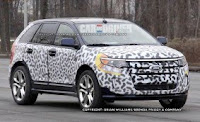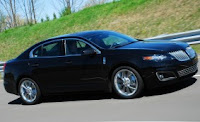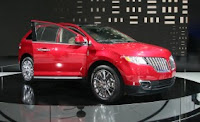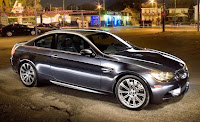A car has got to be pretty spectacular to win over the curmudgeons here at 1585 Eisenhower Place, especially when familiarity sets in over the course of 40,000 miles. But our Sparkling Graphite Metallic M3 did indeed win us over. For less than $70,000, the M3 bolts from a standstill to 60 mph in 4.3 seconds and turns the quarter-mile in 12.7 seconds at 113 mph. It pulls an exceptional 0.96 g on the skidpad, stops in 147 feet from 70 mph, and reaches a governor-restricted 161 mph. On a racetrack or a back road, it�s a beautifully balanced and hugely entertaining machine.
Aside from performance, the M3 is comfortable on the highway and has plenty of space for four adults. It has a full complement of luxury accouterments and yet is very practical�even the trunk is commodious. It has muscular, raked looks and a handsomely dark interior. A bonus is that regular service doesn�t cost a cent, thanks to BMW�s full-maintenance program, which lasts for four years or 50,000 miles. (The gas bill, however, wasn�t cause to rejoice, given this BMW�s 17-mpg thirst.)
When it came to ordering the car, we went with the so-called M double-clutch transmission (M DCT), a $2700 option that replaces the standard six-speed manual with a seven-speed dual-clutch unit, BMW�s first. We were eager to try this setup because dual-clutch transmissions promise the smoothness of an automatic when the driver can�t be bothered to change gears, as well as superfast paddle shifts in manual mode. In the previous M3 (E46), BMW offered a single-clutch, automated manual gearbox that was notable for its harshness in manual mode and its clunkiness as an automatic.
Other options included the $750 Cold-Weather package, a godsend in Michigan winters; the $3250 Technology package that dumps navigation in with electronic adaptive dampers; 19-inch wheels and tires ($1200); and the $1900 Premium package that bundles power folding mirrors and Bluetooth interface along with upgraded leather interior trim that has a distinctive carbon-fiber look.
The interior held up well, but the side of the driver�s seat got scuffed up. Rear-seat space was decent.
Who wouldn�t react favorably to a perform ance car so well rounded? Here�s who: some whiners on staff anxious to get past the 1200-mile engine-break-in period, during which BMW suggests that drivers never use full throttle and refrain from revving higher than 5500 rpm. Once past this period, our crew was fulsome in its praise for the BMW�s everyday drivability�although it pays to keep the variable shocks on their softest setting on poor pavement. We even noted relatively few iDrive complaints, at least until the knob that controls it became loose at 37,000 miles. (It was replaced under warranty, without charge.) BMW has since changed the iDrive interface, and the new setup is far easier to operate. Those who plugged iPods into the M3 were satisfied with the interface between tunes and car.
We always plan for snow in the winter, so at 19,903 miles, we installed a set of Pirelli Winter 240 Sottozero tires on the base 18-inch rims. We racked up 10,500 miles on these tires, during which the M3 proved quite adept at getting around despite all the white stuff that fell in Michigan last winter and spring. The car also rode better on the 18s, although most drivers felt the decrease in ride quality with the 19-inch wheels was worth it for the improved looks.
Spot the missing iDrive knob . . .
The service history was fairly uncomplicated, and with the free regular maintenance, the only out-of-pocket cost for 40,000 miles was $1450 for new tires. Based on our experience, the stock Michelin Pilot Sport PS2s should last roughly 25,000 miles for the rears and 35,000 for the fronts. As for service, after an initial 1200-mile stop to replace the engine oil and the transmission and differential fluids, the BMW�s onboard computer determines the service schedule. It prompted us at 16,210 (engine-oil change), 27,769 (various inspections), and 29,248 miles (engine-oil change).
Due to an oversight, the M3 arrived at our offices without satellite radio installed, so we decided to add Sirius pay-radio service in the car at 13,264 miles�the unwed among us were suffering Howard Stern deprivation�which cost $245 for wiring and programming.
At the 27,769-mile service stop, the M DCT transmission was reprogrammed as part of a service bulletin that resulted from the �sudden loss of engine power when decelerating to a complete stop with light brake application.� M3 forums describe the sensation as being akin to the car stalling due to the transmission holding a higher gear than appropriate. In any event, this mechanical foul-up never bit us.
Over the M3�s long stay, several drivers banged up the perilously low frontal underbody against curbs, inclined driveways, and irritating parking-lot barriers, to the point that we had to replace the engine splash shield and other underbody parts at a cost of $501. Other than this, the car�s exterior (and interior) held up extremely well over its 17 months with us.
The only significant complaints involved the dual-clutch transmission. In automatic mode, it works remarkably well, and it was hard not to be awed by the speed of the shifts and its smoothness of operation. Indeed, technical director Dave VanderWerp observed that it �upshifts so smoothly under part throttle that it�s easier to detect a shift from the change of the exhaust note than it is to feel it. Too bad,� he went on, �that the lazy throttle tip-in from standstill is so off-putting.�
And near the end, the dual-clutch transmission was making clunks and groans. Assistant tech editor K.C. Colwell was adamant that the transmission had loosened up considerably. Twice while the M3 was parked facing downhill, the transmission slipped markedly when the driver was trying to back up. If the clutches need to be replaced, our local dealer quoted us $3296 for the job! So far, none of the M3 forums has reported any issues with M DCT, save for the service bulletin already mentioned. Indeed, most owners seem besotted with the dual-clutch gearbox.
Most of the sentimental drivers on staff would have preferred a manual transmission in the M3, although the automatic function of the M DCT is good for mindless commuting. All around, this M3 was a far better experience than our long-term E46 M3 [March 2003]. Not only is the M3 dramatically improved in acceleration, braking, and skidpad grip, but it was utterly dependable. That 2001 M3 burned through 14 quarts of oil and used to sputter, stumble, and often stall on cold winter mornings. This M3 needed just two remedial quarts, the first of which wasn�t added until 25,000 miles, and the car held a steady idle on even the bitterest cold starts. Based on our experience, the current M3 is the world�s all-around best car for the money, although several staffers would have preferred to trade some of the coupe�s looks for the added practicality of the sedan. Choices, choices
RANTS AND RAVES
K.C. Colwell
This is the finest car on the market, period.
Russ Ferguson
The slow-speed launch can really suck. One auto-shop teacher accelerated very gingerly and got the M3 to buck and hitch like a 16-year-old learning to drive a manual.
Sara Quiroga
My only complaint about this car is that I don�t own it.
Mike Dushane
The dual-clutch transmission short-shifts at the slightest hint of wheelspin in automatic mode. Very annoying. I wind up driving in manual mode all the time, so why not save money and get the manual?
Steve Spence
Very grouchy sometimes in responses to the throttle. And that�s about the only negative to this great, great car.
Tony Quiroga
The M3 didn�t work very well in deep snow�and the winter tires did little to help. But in snow less deep, the M3 tracked beautifully and worked remarkably well.
Track Tires
Here are two truths about self-respecting M3 coupe owners: They would not even consider the optional sunroof that eliminates the distinctive carbon-fiber roof, and it�s likely they will end up driving their cars at a racetrack. That second sure thing happened to us as pseudo-owners, and after a handful of laps we�d obliterated the tread on the stock Michelin Pilot Sport PS2 tires. They simply can�t cope with the amount of heat generated by this 3600-pound thrill machine at its flaming limits.
So we went looking for stickier, street-legal track tires�commonly referred to as �R compound��but finding them in either the M3�s standard 18-inch size or the optional 19-inch dimension was difficult. However, Michelin has one, a BMW-specific version of its Pilot Sport Cup tires, in only the 19-inch size. In fact, these tires originated with the Euro-only, lightweight CSL edition of the previous-generation M3.
Available only as a replacement tire, this �Sport Cup +� version (fronts, $353 each; rears, $416) features additional grooving in the tread, which compromises stiffness to be friendlier in the rain (which it is) compared with an off-the-shelf Sport Cup. And these tires are also able to withstand higher temperatures than the stock PS2s. Unfortunately, skidpad results were no better with the Sport Cups (0.96 g), and braking (156 feet) was a bit worse.
On a racetrack or a back road, it�s a beautifully balanced and hugely entertaining machine.
We returned to the 1.9-mile GingerMan Raceway in South Haven, Michigan, where we�d chewed up our stock tires, with much improved results. Although it didn�t feel like there was a whole lot more stick in the corners (our best time was a 1:38.1), more important, lap times remained consistent. But after almost 1000 street miles and a couple of dozen hard laps at GingerMan, the fronts (see photo) had 2/32nds of an inch of tread left. The rears fared better, only burning through half (3/32-inch) of their tread. Even though the BMW-specific Sport Cups didn�t outgrip the PS2s, having a tire that�s consistent and lasts significantly longer during abusive lapping is indeed a boon for the track-rat M3 owner.
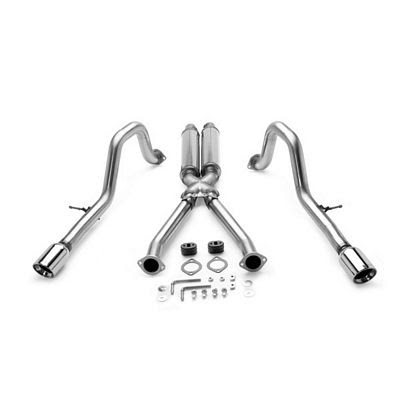




 Taking weight out of a modern car can be tricky: Crash regulations have necessitated heavier structures, emissions laws have forced additional complexity into vehicles, and amenities have added dozens of electronic control units and untold miles of cable. Many automakers, however, are now experimenting with shedding pounds as a means to maintain performance despite the current trend toward engine downsizing. To illustrate the potential of this approach, Audi engineers set out to create an A5 2.0T that weighs 500 pounds less than a 3400-pound Euro-spec A5 V-6 model (U.S. versions weigh roughly 200 to 300 pounds more due to options and higher levels of standard equipment). The result is an A5 coupe that, according to Audi, tips the scales at a svelte 2888 pounds despite retaining the 2.0-liter�s heavy iron block.
Taking weight out of a modern car can be tricky: Crash regulations have necessitated heavier structures, emissions laws have forced additional complexity into vehicles, and amenities have added dozens of electronic control units and untold miles of cable. Many automakers, however, are now experimenting with shedding pounds as a means to maintain performance despite the current trend toward engine downsizing. To illustrate the potential of this approach, Audi engineers set out to create an A5 2.0T that weighs 500 pounds less than a 3400-pound Euro-spec A5 V-6 model (U.S. versions weigh roughly 200 to 300 pounds more due to options and higher levels of standard equipment). The result is an A5 coupe that, according to Audi, tips the scales at a svelte 2888 pounds despite retaining the 2.0-liter�s heavy iron block.
 To fill the gap in the 3-series lineup between the 300-hp 335i and 414-hp M3, BMW is introducing the 2011 335is coupe and convertible. We were unaware that said gap needed to be filled, but we�re told that the 335i is seen in the U.S. as just an ordinary 3-series, and as such, there�s room for something more exotic than a 335i but less outlandish than an M3. Now that we�ve been given the chance to drive the 335is coupe, we�re coming around to accepting this whole gap idea.
To fill the gap in the 3-series lineup between the 300-hp 335i and 414-hp M3, BMW is introducing the 2011 335is coupe and convertible. We were unaware that said gap needed to be filled, but we�re told that the 335i is seen in the U.S. as just an ordinary 3-series, and as such, there�s room for something more exotic than a 335i but less outlandish than an M3. Now that we�ve been given the chance to drive the 335is coupe, we�re coming around to accepting this whole gap idea. 

